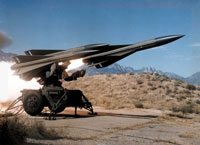
|
||
|
HAWK |
||||||||||||||||||||||
|
The Raytheon MIM-23 HAWK is an American medium range surface-to-air missile. The HAWK was initially designed to destroy aircraft and was later adapted to destroy other missiles in flight.
The missile entered service in 1960, and a program of extensive upgrades has kept it from becoming obsolete.
It was superseded by the MIM-104 Patriot in United States Army service by 1994.
It was
finally phased out of US service in 2002, the last users, the US
Marine Corps replacing it with the man-portable IR-guided visual range
FIM-92 Stinger. The missile was also produced outside the US in
Western Europe and Japan.
The HAWK
system consists of a large number of component elements. These
elements were typically fitted on wheeled trailers making the system
semi-mobile. During the system's 40-year life span, these components
were continually upgraded.
|
||||||||||||||||||||||
